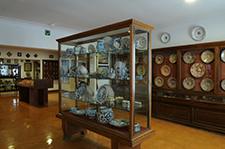Ceramics and Glassware Halls (Halls 12, 13 and 14)

In Hall 12, there are 90 pharmacy jars, or albarelos. Decorated with coats of arms, they serve as a reminder of the important role played in the past by the pharmacies run by monasteries and convents. Along with the pharmacy jars, notice the wonderful collection of ink bottles and spice pots on view in a showcase and on top of a table. The singular display design is also worth noting.
Several earthenware jugs and bowls from Talavera and Puente del Arzobispo are located in the central showcase-beautiful pieces decorated with polychrome scenes of animals and knights. The lower section features a bowl with a bullfighting scene from Talavera de la Reina, one of the most influential centers for the production of Spanish ceramics.
Hall 14 is dedicated exclusively to gilded ceramics produced in Manises, Catalonia and Aragon, almost all from the 16th and 17th centuries. Gilded and metallic ceramics require several firings. A coat of white glaze which has already been fired is then topped by an alloy of various metals that has been dissolved in vinegar. Another firing results in this metallic sheen.
In Hall 13, there are more examples of gilded ceramics. Another special collection is a grouping of blue Catalan ceramic plates from the 18th century, whose surface is replete with decoration.
Lastly, there are two interesting works from the Alcora Ceramic Factory, the first Spanish establishment dedicated to the industrial production of high quality ceramics. In the center of the room, notice the glazed copy of a Hellenistic piece known as the Farnese Bull. There is also a plaque from the Way of the Cross, another work from Alcora. The eleventh of the fourteen Stations of the Cross is hung on the gallery wall.


